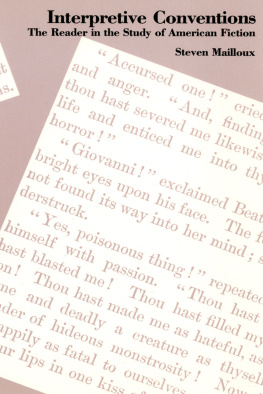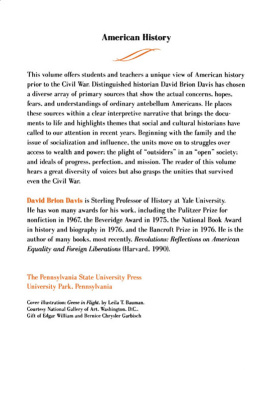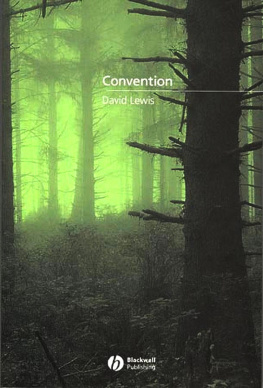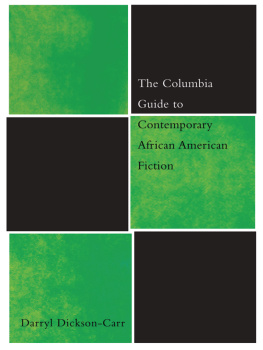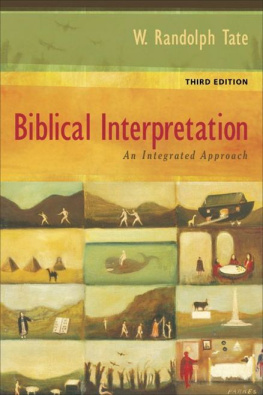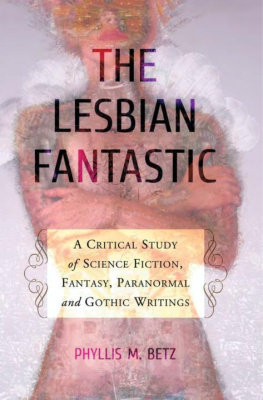Mailloux - Interpretive conventions: the reader in the study of American fiction
Here you can read online Mailloux - Interpretive conventions: the reader in the study of American fiction full text of the book (entire story) in english for free. Download pdf and epub, get meaning, cover and reviews about this ebook. City: Ithaca [etc, year: 1984;2017, publisher: Cornell University Press, genre: Art. Description of the work, (preface) as well as reviews are available. Best literature library LitArk.com created for fans of good reading and offers a wide selection of genres:
Romance novel
Science fiction
Adventure
Detective
Science
History
Home and family
Prose
Art
Politics
Computer
Non-fiction
Religion
Business
Children
Humor
Choose a favorite category and find really read worthwhile books. Enjoy immersion in the world of imagination, feel the emotions of the characters or learn something new for yourself, make an fascinating discovery.
Interpretive conventions: the reader in the study of American fiction: summary, description and annotation
We offer to read an annotation, description, summary or preface (depends on what the author of the book "Interpretive conventions: the reader in the study of American fiction" wrote himself). If you haven't found the necessary information about the book — write in the comments, we will try to find it.
Mailloux: author's other books
Who wrote Interpretive conventions: the reader in the study of American fiction? Find out the surname, the name of the author of the book and a list of all author's works by series.
Interpretive conventions: the reader in the study of American fiction — read online for free the complete book (whole text) full work
Below is the text of the book, divided by pages. System saving the place of the last page read, allows you to conveniently read the book "Interpretive conventions: the reader in the study of American fiction" online for free, without having to search again every time where you left off. Put a bookmark, and you can go to the page where you finished reading at any time.
Font size:
Interval:
Bookmark:
I thank the following people for the suggestions and encouragement that helped me write this book: Charles Altieri, Monroe Beardsley, Henry Binder, David Bleich, Roland Champagne, Michael and Thomas Clark, Jonathan Culler, Judith Davidoff, Hermione de Almeida, Stanley Fish, Walter Fisher, Gerald Graff, Norman Holland, Terry Lyle, T. Edith and Russell Mailloux, George McFadden, Guy Nishida, Hershel Parker, Adena Rosmarin, William Stockert, Susan Suleiman, Jane Tompkins, Alan Wilde, W. Ross Winterowd, and Mary Ann and F. Roman Young.
I extend special thanks to William Cain, Peter Carafiol, and Michael Sprinker for offering valuable criticism of a near-final draft. I am also grateful to Kay Scheuer of Cornell University Press for her close reading of the final manuscript.
A National Endowment for the Humanities Fellowship gave me the released time to complete the book, and the University of Miami provided funds for research, duplicating, and other expenses.
Portions of Chapters 1 and 2 appeared in Genre, 10 (1977), The Journal of Aesthetics and Art Criticism, 38 (1979), and Centrum, n.s. 1 (1981). Two sections of Chapter 7 were first published in Studies in the Novel, 10 (1978); and material in the conclusion appeared in Centrum, n.s. 1 (1981), and Reader, No. 5 (1978). An earlier version of the appendix was published in College Composition and Communication, 29 (1978). I am grateful to the publishers for permission to reprint.
Finally, I thank the person to whom I owe the most. I could not have written this book without Mary Ann Mailloux.
S. M.
Are rhetoric and poetics separate and discrete fields of study? Although rhetorical theorists from Aristotle to Kenneth Burke have pointed out the overlap between these two areas, detailed discussion usually centers on showing their distinctiveness. The common ground of rhetoric and poetics is a no mans land, the limbo of the faithless, for no self-respecting esthetician will vulgarize his subject by glancing, even momentarily, at rhetoric, and the rhetorician, though generally much more comprehensive in his viewpoint than the esthetician, is so busied with the practical discourses of history (both past and present) that he seldom has time to concern himself with poetry. Extended entry into this no mans land is long overdue, and especially so now that English departments are becoming more aware of their dual responsibility to teach composition and promote literary study. A sharp distinction between rhetoric and poetics encourages us to view these duties as two completely separate functions. Actually, the study of literature and the teaching of writing are closely related and mutually illuminating. In fact, recent trends in literary criticism suggest that a rapprochement may be taking place between literary and composition theory; shared paradigms are now emerging. In this Appendix I will outline these developing areas of shared theory and practice, emphasizing the role of reader-response criticism as a growing bond between rhetoric and poetics.
Observation and interpretation always proceed within accepted Since the 1940s, New Critical formalism has clearly served as the dominant paradigm in American criticism and theory. This objective approach (in its purest form, at least) viewed a literary work as an artifact, cut off from both authorial intention and reader response. It rejected external criticism and restricted its analysis to the work in and of itself. Many New Critics spacialized the text, viewing its parts in relation to the artistic whole, a tightly organized network of structures. This American New Criticism provided little of interest to rhetoricians. It not only ignored the audience, a central concern of rhetoric; it also actively discouraged talk about readers through its condemnation of the Affective Fallacy.
In recent years there have been many reactions against New Criticism. In one such reaction, a model of literature as communication challenges the established model of literature as aesthetic product. Those critics using this revitalized communication model practice the Intentional and Affective Fallacies with impunity. This new paradigm of criticism has much more to offer the composition teacher than did the old formalist paradigm, and it is here that we can begin to see the recent overlap of rhetoric and poetics most clearly. Two contemporary critical approaches that work within the model of literature as communication are textual-biographical and reader-response criticisms.
Recent textual-biographical critics view art as process, not as product. This may at first seem contradictory to our usual notion that textual editors are interested only in establishing a product, the intended text for a critical edition. But such a portrayal is incomplete. As we saw in Chapter 4, the scholarly editor establishes his text based on the authors final intention, and
From a complementary perspective, recent reader-oriented critics have also viewed art as communicative process. As . H. Abrams puts it: Since the late 1950sthere has been a strong revival of interest in literature as a public act involving communication between author and reader, and this has led to the development of a rhetorical criticism which, without departing from a primary focus on the work as such, undertakes to analyze those elements within a poem or a prose narrative which are their primarily for the readers sake. By describing these actions, reader-response critics discard the Affective Fallacy and join the New Scholars in rejecting the chief proscriptions of American New Criticism.
Whereas the old New Critical paradigm was hostile to any synthesis of rhetoric and poetics, the new paradigm that views literature as a temporal act of communication provides much encouragement for a rapprochement between literary criticism and composition theory. Like textual-biographical critics, composition theorists stress the importance of viewing the composing process as a series of acts by the writer. These shared concerns and perspectives should encourage more exchanges between current rhetoric and poetics, exchanges that will benefit both disciplines and English studies as a whole.
A simple view of the composing process based on the traditional rhetorical categoriesinvention, arrangement, and stylewill further illustrate the fit between composition theory and recent literary criticism (primarily reader-response approaches). In what follpws I will oversimplify the composing process and fall into such heresies as implying a form-content split. My point, however, is simply to provide a clear framework for examining some additional parallels between literary criticism and composition.
The goal of the composition teacher is to give the student writer alternative choices at every stage of the composing process. For example, in the area of invention (the generation of subject matter), the student has at least two alternatives: brainstorming and heuristics. Brainstorming is an unsystematic way of asking questions about a topic, while heuristics are systematic ways of asking questions. Clearly, then, literary criticism can provide resources for the composition teacher at the stage of invention.
Once subject matter is generated, what choices of form are available to the student? Again, literary theory provides some useful models for the composition teacher. To Burke, form is the psychology of the audience; it is an arousing and fulfillment of desires. A work has form in so far as one part of it leads a reader to anticipate another part, to be gratified by the sequence. At the level of arrangement, a temporal reader-oriented criticism encourages the composition teacher to make student writers aware of the expectations they set up in their essays and sensitive to their own ordering of the readers responses.
Font size:
Interval:
Bookmark:
Similar books «Interpretive conventions: the reader in the study of American fiction»
Look at similar books to Interpretive conventions: the reader in the study of American fiction. We have selected literature similar in name and meaning in the hope of providing readers with more options to find new, interesting, not yet read works.
Discussion, reviews of the book Interpretive conventions: the reader in the study of American fiction and just readers' own opinions. Leave your comments, write what you think about the work, its meaning or the main characters. Specify what exactly you liked and what you didn't like, and why you think so.

